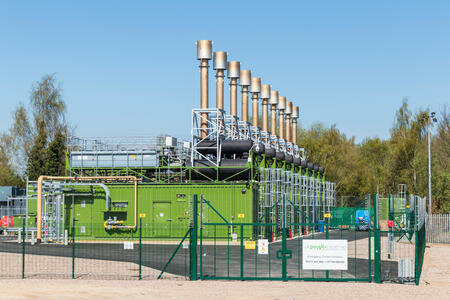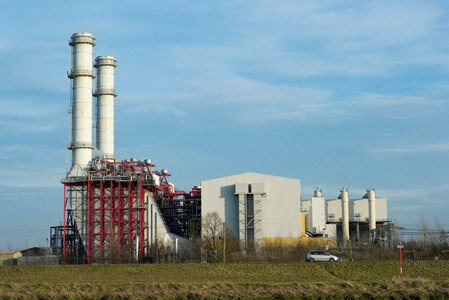
 POWEROP: UNIT COMMITMENT POWEROP: UNIT COMMITMENTAND ECONOMIC DISPATCH SOFTWARE TO OPTIMISE THE SHORT-TERM SCHEDULING AND LONGER-TERM PLANNING OF ELECTRICAL POWER GENERATION Electricity generating companies and power system operators have the problem of deciding how best to meet the varying demand for electricity, which has a daily and weekly cycle as well as some longer-term issues. Their short-term optimisation problem is how to schedule generation to minimise the total fuel cost, or to maximise the total profit, over a study period of typically a day, subject to a large number of constraints that must be satisfied. In the longer term, an electricity company needs to purchase fuel and/or trade fuel and power contracts and satisfy any emission constraints it may have. If an electricity company has responsibility for satisfying the demand for electricity, then its most important short-term constraint is that the total generation must equal the forecast demand in each time-interval (which is typically 30 or 60 minutes long). Alternatively, a generating company in a deregulated electricity market may not need to match its demands exactly, but it will have to decide at what prices to offer its generating plant to the market at different times of the day. There are two related short-term optimisation problems, 'unit commitment' and 'economic dispatch'. Unit commitment is the process of deciding when and which generating units at each power station to start-up and shut-down. Economic dispatch is the process of deciding what the individual power outputs should be of the scheduled generating units at each time-point. Unit commitment is a very challenging optimisation problem, because of the astronomical number of possible combinations of the on and off states of all the generating units in the power system over all the time-points in the study period. For planning purposes, the same optimisation problems need to be solved over a longer study period, such as a year, in order to allocate resources in the most effective way. Power Optimisation is an independent consultancy, which develops unit commitment software called Powerop for electricity companies. This software considers both unit commitment and economic dispatch simultaneously, which improves the quality of the calculated generation schedules. Powerop has an option called Planner for longer-term planning studies. This automates repeated short-term runs (such as over a week) of Powerop to cover a longer study period such as a year. Planner is able to optimise whilst taking into account longer-term issues such as fuel contracts and emission limits, and it also allows for both scheduled maintenance overhauls and random breakdowns of generating units. Powerop can be used by power system operators to schedule and dispatch the generating units in their power systems, to produce very high quality generation schedules that take into account all the important constraints on the power system and on the generating units. The software has a number of features that are suitable for the particularly difficult problems faced by the operators of power systems on islands. Powerop is being used for self-scheduling by some major generating companies under the British Electricity Trading and Transmission Arrangements (BETTA) in the British electricity market.
Powerop is based on a proprietary solution algorithm developed by Power Optimisation, which is a multi-stage version of the Mixed Integer Linear Programming (MILP) Method. This has the following advantages:
The objective of the optimisation is to minimise the total fuel costs over the study period whilst satisfying the appropriate constraints. Alternatively, the objective of the optimisation can be to maximise 'profit', defined as the total revenue from electricity sales minus fuel costs. The study period is divided into time-intervals chosen by the user, which are usually half-hourly or hourly (but longer or shorter time-intervals can also be used). For most power systems, study periods of up to a week with half-hourly time-intervals can be solved to good accuracy by Powerop within an acceptable run time. For very large power systems and / or longer study periods, Powerop's Planner option can be used to automatically perform repeated linked short-term Powerop studies which can optimise limited resources over the long-term. Powerop takes into account any combination of the
following features and constraints of the power system being modelled:
Types of Generating Units The software can model the operation of both thermal and hydro-electric generating units
and of electricity contracts with other companies. Thermal generating units can include coal-fired,
oil-fired, gas-fired and nuclear-powered steam turbines, and combustion turbines burning distillate
(which are often called gas turbines). Thermal units can also include dual-fired generating units,
which can use one of two alternative fuel types. The software can model and optimise the use
of mixtures of different fuels and/or gas contracts in the same generating unit or group of units.
The hydro-electric units can include conventional hydro units and pumped storage units.
Gas-fired units and hydro-electric units are treated as energy-limited plant.
Energy storage units, such as battery storage and pumped storage,
can be modelled and their operation optimised. Upper or lower
energy limits may also be applied to other types of generating units and may be used, for example,
to represent limited fuel supplies or ‘take or pay contracts’.
Renewable generation, such as wind farms and solar power,
can be modelled as pseudo-generating units with zero fuel costs and time-varying availabilities,
which might represent the forecast total wind power or solar power in a particular region.
System Constraints
Transmission Constraints
Cost Characteristics of Generating Units
Scheduling Constraints on Individual Generating Units
Dispatching Constraints on Individual Generating Units
Station Constraints
 Electricity Contracts An electricity contract with another company can be modelled as a pseudo-generating unit or as a ‘demand’ unit. This option offers all the features described above, for example ramp rates, energy limits, and minimum on and off times, which can be useful if the electricity contract contains such features. The software also has an option for the direct modelling of the electricity contracts
which are offered on power exchanges or by electricity brokers. Electricity contracts
(also known as power contracts) may be of type ‘buy’ or ‘sell’.
The software models the details of the electricity contracts that are offered on the British contracts market.
Electricity contracts may optionally be grouped, so that if one contract in a group is accepted then all
the other contracts in that group must be accepted. This direct modelling of electricity contracts allows
the software to consider a much larger number of such contracts than if they were modelled as
pseudo-generating units. This provides guidance to the electricity company as to which contracts
to accept and at what volumes, in order to maximise profits, whilst taking into account the knock-on
effects of accepting those contracts on the outputs of the physical generating units, including the
effects of ramp rates.
Initial Conditions
Import and Export across an Interconnector
Modes of Operation The software is able to use pseudo-generating units to model different modes of operation of
generating plant, with logical constraints defined by the user preventing simultaneous operation of
any incompatible modes. For example, the user might define different pseudo-generating units in
the software’s input data for the following modes of operation of a Combined Cycle Gas Turbine (CCGT)
power station that has two gas turbines and one steam turbine: Mode A is Gas Turbine 1 operating in
‘open-cycle mode’, Mode B is Gas Turbine 2 operating in ‘open-cycle mode’,
Mode C is Gas Turbine 1 operating in ‘combined-cycle mode’ with the Steam Turbine,
Mode D is Gas Turbine 2 operating in ‘combined-cycle mode’ with the Steam Turbine,
and Mode E is Gas Turbines 1 and 2 operating together in ‘combined-cycle mode’ with the Steam Turbine.
The thermal efficiencies, ramp rates and other data items of these modes will not all be the same.
This can be modelled by Powerop using pseudo-generating units and appropriate logical constraints
specified by the user.
Longer-Term Issues When performing a planning study over a period of, say, one year, some considerations apply over all or most of the year, rather than at one particular time. Such issues include:
Most of the features described above, particularly those for reserve and transmission constraints,
are relevant to power system operators using the software to schedule and dispatch their power systems
in a secure and economic way.
The software has some special options for use by generating companies that are self-scheduling under the British Electricity Trading and Transmission Arrangements (BETTA) in the British electricity market. Companies using the software under BETTA schedule their generating units against half-hourly 'Net Contract Positions' in MegaWatt Hours (MWh). The software can model general market prices for electricity, and can also be used to model individual ‘buy’ and ‘sell’ contracts for electricity with their particular characteristics and prices (see the section on electricity contracts above). This provides guidance to the electricity company as to which contracts to accept and at what volumes, in order to maximise profits, whilst taking into account the knock-on effects of accepting those contracts on the outputs of the physical generating units, including the effects of ramp rates. Powerop has an option to calculate the minute-by-minute output profiles for each generating unit
for the 'physical notifications' that are required under the BETTA rules. These output profiles
satisfy the constraints on the generating units, whilst minimising imbalances between the total
integrated output profiles and the Net Contract Positions. The Powerop study period can be up to
several days long, with half-hourly time-intervals. Longer-term studies are possible using
the Planner option.
Powerop runs on a computer with a Windows operating system and is supplied with a sophisticated
user-interface based on Microsoft Excel workbooks. Alternatively, it can be used as a solution engine
communicating via simple text files with a user-interface developed by the customer, which allows
closer integration between Powerop and the customer’s other software systems. The Excel user-interface
is recommended for an initial evaluation of Powerop, because it is easy to use and understand.
Buckinghamshire, HP9 1JJ, England, United Kingdom. UK Telephone: 01494 675175. International Telephone: +44 1494 675175. E-mail: info@powerop.co.uk  |